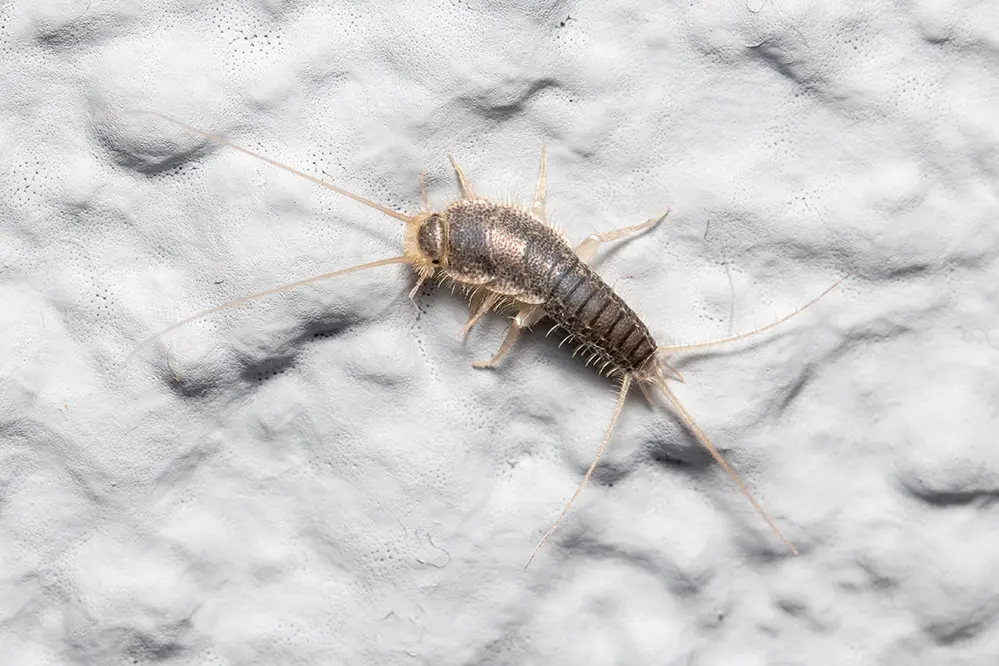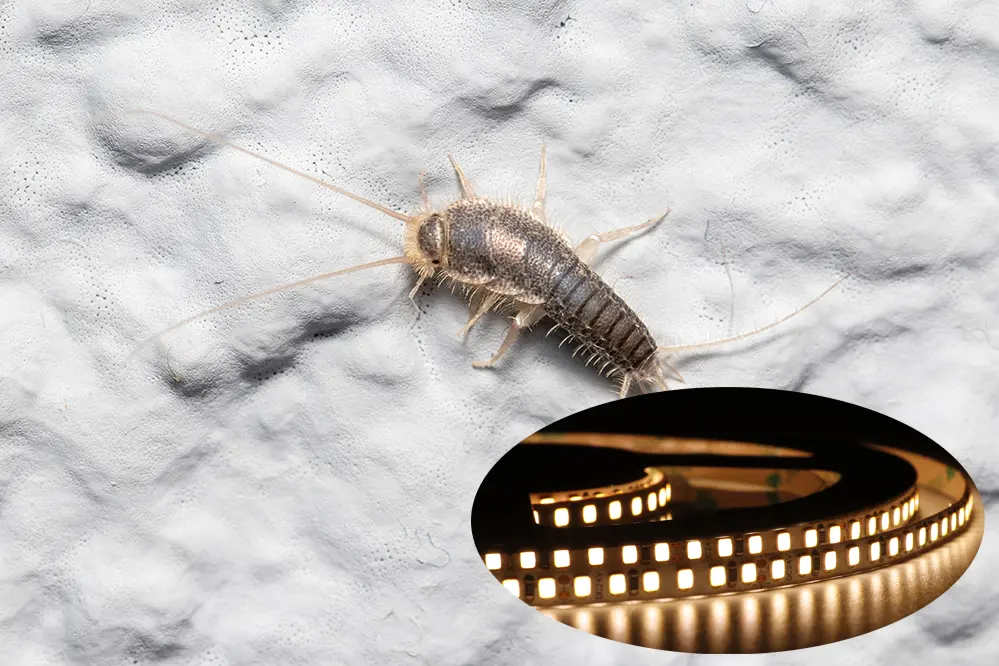Are you wondering if LED lighting attracts silverfish? Look no further! In this blog post, we have the answer to your question and valuable insights on how LED lighting can help deter these pesky pests from your home.
LED lighting does not attract silverfish. These nocturnal insects have a natural aversion to light and prefer dark environments. By keeping your home well-lit with LED lights, you can discourage silverfish from taking up residence and minimize the chances of an infestation.
Discover the fascinating habits of silverfish, learn effective prevention strategies, and find out how LED lighting can play a crucial role in creating an inhospitable environment for these unwanted guests. Don’t miss out on the valuable information we have in store for you!
Debunking LED Light Myths

It’s a common misconception that LED lights exacerbate insect infestations; in reality, they do not entice silverfish.
Indeed, due to their design features, LED luminaries emit less heat and UV light compared to their incandescent counterparts – making them less appealing to many types of insects, silverfish included.
Thus, the notion of “LED-friendly” pests stands contrary to verified entomological studies.
Silverfish’s Light Aversion
Silverfish actively avoid illuminated areas, preferring darkness for their nocturnal activities and secretive nature.
In darkness, silverfish find security and sustenance, and light disrupts their essential survival behaviors.
When exposed to LED lighting, which is less attractive to many nocturnal insects, silverfish retreat, seeking more conducive environments.
Maintaining well-lit spaces, especially with LEDs, creates a barrier—a deterrent that compels silverfish to abandon an area in pursuit of darkness.
LED Lights vs. Traditional Bulbs
LED lights are known for their energy efficiency compared to traditional incandescent bulbs.
While incandescents convert much of their energy into heat, LEDs utilize their energy more effectively, producing more light per watt, thereby generating minimal heat in the process.
LEDs also have a significantly longer lifespan, often lasting tens of thousands of hours, compared to the relatively short life of traditional bulbs.
Additionally, LEDs offer a versatility in color temperature and dimmability that incandescent bulbs struggle to match, enhancing the potential for mood lighting and personalized spaces.
Transitioning to LED lighting can result in lower energy bills and reduced replacement costs over time.
Silverfish Habits and Habitats

Silverfish are predominantly thigmotactic insects, meaning they prefer environments where they can make contact with surfaces. These reclusive pests favor damp, cool conditions and can often be found in areas with high humidity levels, such as basements or bathrooms. They are not only elusive but also resilient, able to survive in a range of temperature variations and domestic conditions.
This proclivity for moisture dictates their feeding grounds. Silverfish are particularly attracted to polysaccharides, such as starches and cellulose found in common household items like books, wallpaper glue, and cotton. Yet, despite their dietary inclinations, they exhibit remarkable fasting endurance, capable of enduring prolonged periods without sustenance.
Nocturnal Lifestyle Explained
Silverfish exhibit a distinct preference for nocturnal activity, thriving during the night when human activity is minimal.
- Darkness: Serves as a protective cloak, enabling silverfish to search for food and mates undisturbed.
- Quiet: Lower levels of noise at night reduce the likelihood of silverfish encountering predators or disturbances.
- Coolness: Nighttime temperatures are often cooler, aligning with silverfish’s preference for cooler habitats.
- Humidity: Night air can be more humid, which silverfish find optimal for their survival.
Their aversion to daylight compels them to seek refuge in the shadows during daytime hours.
Adapted to evade detection, silverfish capitalize on the shield of night to sustain their clandestine lifestyle.
Ideal Conditions for Infestation
Silent corners breed undisturbed silverfish populations.
In residential habitats, silverfish flourish under specific conditions. A combination of high humidity, ambient warmth, and ample darkness creates an optimal breeding ground for these pests. Often, these factors are prevalent in undisturbed areas such as attics, basements, and closets, where inadvertent collections of paper, fabric, and other delectable items quietly await their feast.
An uncontrolled moisture level is their ultimate haven.
Areas rich in organic matter and starchy substances – particularly kitchens and storage rooms – become silverfish havens. Here, rotting foodstuffs, damp papers, and cardboard boxes provide not only sustenance but also nesting sites for silverfish. With discreet ingress points for these insects, an infestation becomes increasingly plausible.
Prevention involves meticulous moisture control and sanitation.
To curtail the invasion and proliferation of silverfish, homeowners must diligently manage humidity levels. By integrating strategic ventilation, regular cleaning regimens, and dehumidification efforts, the allure of domestic environments to silverfish is significantly reduced. Proactive barrier maintenance in 2023 will become increasingly vital as homeowners seek sustainable methods for deterring these ancient insects without resorting to hazardous chemicals.
Mitigating Silverfish Infestations
To decisively confront silverfish infestations, comprehensive environmental adjustments are imperative. This begins with identifying and repairing any leaks in plumbing or gaps in walls that increase humidity, as these conditions pave the way for silverfish settlement. Furthermore, regular vacuuming is essential to remove potential food sources, including minute particles of skin, hair, and crumbs that may attract these pests.
Implementing strategic storage solutions can also stifle the proliferation of silverfish. Sealing books, off-season clothing, and other prone materials in plastic containers ensures that these items do not become inadvertent breeding grounds. In essence, reducing excess clutter and maintaining meticulous cleanliness are fundamental steps in creating a hostile environment for silverfish habitation.
Effective Home Lighting Strategies
Strategic illumination is pivotal in creating inhospitable conditions for pests like silverfish, with LEDs being a particularly efficient option.
- Utilize LED lighting to illuminate dark spaces, deterring silverfish that prefer shadowy environments.
- Install motion-sensor lights in infrequently used areas to maintain an energy-efficient, pest-deterring lighting system.
- Opt for cool white or daylight bulbs to simulate natural lighting, which is less conducive to silverfish habitats.
- Incorporate ambient lighting in storage areas, such as closets, where these insects may seek refuge.
- Employ timing devices to automate lighting, ensuring consistent light exposure in potentially vulnerable spaces.
Consistent lighting coverage minimizes the niches silverfish seek, maintaining a barrier against infestation.
Well-executed lighting strategies transcend mere aesthetics, serving as an ecological defense against nocturnal pests.
Importance of Environmental Control
Maintaining a stable environment is crucial in deterring silverfish infestation.
- Regulate humidity with dehumidifiers to reduce the moisture silverfish thrive upon.
- Inspect and seal cracks to prevent entry points for these elusive pests.
- Monitor room temperature, keeping it at or below 17 degrees Celsius to discourage silverfish habitation.
- Optimize ventilation, specifically in moist areas, to create unfavorable conditions for silverfish.
Consistent environmental management can act as a deterrent to silverfish.
Proactive steps in environmental control are essential for long-term silverfish prevention.
Preventative Measures for Homeowners
Vigilance in environmental management is pivotal for homeowners to prevent silverfish occupation. By strategically placing dehumidifiers in high moisture areas, one can suppress the humid conditions conducive to silverfish proliferation. Additionally, regular inspection of residences for cracks and crevices, followed by meticulous sealing, can thwart potential entry points for these pests, reinforcing the home’s defenses.
To further bolster a silverfish-free environment, homeowners should cultivate dry, cool, and well-ventilated living spaces. Leveraging environmental controls such as air conditioning to lower ambient temperatures, particularly in the sultry months, creates an uninviting atmosphere for silverfish. Emphasizing cleanliness with routine vacuuming to eliminate food particles and possible sustenance for silverfish is essential. Regularly decluttering storage areas and sealing off potential hiding spots can also help prevent silverfish infestations.
In summary, LED lighting does not attract silverfish. These nocturnal pests are naturally averse to light and prefer dark, moist environments. By maintaining well-lit spaces with LED lights, homeowners can discourage silverfish from taking up residence in their homes. Additionally, implementing environmental controls such as regulating humidity, sealing cracks, and practicing good sanitation can further prevent silverfish infestations. With these preventative measures in place, homeowners can enjoy a silverfish-free living environment.Furthermore, it is important to address any existing silverfish infestations promptly and effectively.
Here are some additional measures to mitigate silverfish populations:
- Natural Predators: Encourage the presence of natural predators of silverfish, such as spiders. Keeping a clean and clutter-free environment can attract these beneficial insects.
- Pesticides: If the infestation is severe, consider using non-toxic pesticides specifically designed for silverfish control. Follow the instructions carefully and use them sparingly in targeted areas.
- Sticky Traps: Place sticky traps in areas where silverfish are commonly found, such as basements, bathrooms, and kitchens. These traps can help capture and monitor silverfish activity.
- Sealing Entry Points: Inspect your home for any cracks, gaps, or openings that silverfish can use to enter. Seal these entry points using caulk or other appropriate materials to prevent their access.
- Proper Food Storage: Store food items in airtight containers to minimize potential food sources for silverfish. This includes dry goods, pet food, and pantry items.
- Regular Cleaning: Vacuum and sweep regularly to remove crumbs, debris, and other potential food sources. Pay special attention to areas where silverfish are commonly found, such as under appliances, in closets, and along baseboards.
- Dehumidification: Use dehumidifiers in areas prone to high humidity, such as basements and bathrooms. Maintaining a dry environment can discourage silverfish from thriving.
By implementing these preventative measures and taking appropriate action against existing infestations, homeowners can effectively control and prevent silverfish from residing in their homes. Remember to consult with a professional pest control service if the infestation persists or if you require additional assistance.
FAQs
Are silverfish sensitive to LED?
Silverfish are not sensitive to LED lights. These insects are typically more attracted to sources of warmth and humidity, as well as areas with high levels of starch and cellulose, which they feed on. LED lights do not emit significant amounts of heat, nor do they produce the wavelengths that typically attract silverfish. Therefore, silverfish are unlikely to be attracted to LED lights in the same way they might be to other light sources.
LED lights emit a narrow spectrum of light, focused on specific wavelengths. This targeted lighting makes them energy-efficient and long-lasting, but it does not replicate the natural light spectrum that attracts silverfish. Silverfish are more sensitive to the ultraviolet (UV) wavelengths that are emitted by traditional incandescent or fluorescent lights.
In addition, silverfish are typically more active during the night and prefer dark and damp environments. LED lights do not create the same conducive conditions for silverfish as other light sources that emit more heat or provide a suitable habitat for their survival.
Therefore, if you are concerned about attracting silverfish, using LED lights can be a beneficial choice as they are not likely to act as a draw for these insects.
What bugs do LED lights attract?
LED lights have become increasingly popular in homes, businesses, and outdoor spaces due to their energy efficiency and long lifespan. However, one common concern is the attraction of bugs to LED lights.
While it is often believed that LED lights do not attract bugs, the truth is a bit more complicated. LED lights emit very little heat compared to traditional incandescent or halogen bulbs. Insects are typically attracted to light sources that produce heat, so LED lights are less likely to attract bugs in comparison.
That being said, certain factors can still influence bug attraction to LED lights. The color temperature and intensity of the light can play a role. Bugs are generally more attracted to warm-colored lights, such as yellow or orange, than cool-colored lights, such as blue or white. Additionally, higher intensity lights are more likely to attract insects than lower intensity ones.
To further minimize bug attraction to LED lights, it is recommended to use fixtures with shades or covers to direct the light downward and reduce the visibility of the light source. Additionally, positioning lights away from areas where insects tend to congregate, such as entrances or gathering spaces, can help decrease bug activity around LED lights.
In conclusion, while LED lights are generally less attractive to bugs compared to traditional light sources, factors such as color temperature, light intensity, and positioning can still influence bug activity. Taking these factors into consideration can help minimize the presence of insects around LED lights.
What are silverfish attracted to?
Silverfish are attracted to certain environmental conditions and food sources. They are typically drawn to dark, damp areas with high humidity, such as basements, bathrooms, and kitchens. These pests thrive in spaces that provide a moist environment for them to breed and live.
In addition to favorable conditions, silverfish are attracted to starchy or sugary substances. They feed on items like paper, glue, books, cardboard, and fabrics that contain polysaccharides and dextrins. These materials provide a source of nourishment for silverfish and can be found in many common household items.
To prevent silverfish infestations, it is important to eliminate their preferred habitats by reducing moisture levels and addressing any leaks or dampness in your home. Proper ventilation and dehumidification can help create an inhospitable environment for silverfish. It is also recommended to store susceptible items in airtight containers and regularly clean and declutter areas where silverfish might hide.
While silverfish may seem harmless, they can cause damage to items and fabrics over time. Taking preventive measures and addressing any silverfish sightings promptly can help protect your home and belongings from these pests. If you suspect a silverfish infestation, it is best to consult with a professional pest control service to effectively eradicate the problem.
Light plays a significant role in the behavior of silverfish. While silverfish are primarily nocturnal creatures, they are not necessarily scared of light. In fact, silverfish are attracted to dark and damp environments, which is why they are commonly found in basements, attics, and bathrooms. However, exposing them to bright light can disrupt their natural behavior and cause them to scatter or seek shelter.
Does light scare silverfish?
Light does not typically scare silverfish. Silverfish are nocturnal creatures, meaning they are more active during the night and prefer dark areas. They are also known to be photophobic, which means they prefer to avoid light in general.
While silverfish may avoid bright lights, it is not because they are specifically scared of the light itself. It is more likely that they associate bright light with exposure and potential danger, so they tend to seek out dark and hidden areas to feel safe.
However, it’s important to note that silverfish can still be attracted to certain types of light sources. They are known to be drawn to the warm glow of incandescent lights and may gather around them. This behavior is believed to be due to the heat produced by these lights, as silverfish are attracted to warmth.
In conclusion, while light does not scare silverfish, they tend to avoid bright light and prefer dark, hidden areas. Understanding their behavior can help in implementing effective pest control strategies if you are dealing with a silverfish infestation.
How do silverfish react to LED light?
Silverfish are known to have a unique reaction to LED light. In 2016, researchers conducted a study to understand how silverfish respond to different light sources. They discovered that silverfish are attracted to LED lights, especially those with a bluish-white color temperature. This finding goes against the common belief that silverfish are repelled by bright lights.
Interestingly, silverfish are more likely to be drawn towards LED lights that emit wavelengths in the range of 400-500 nanometers. This specific range of light is often found in the blue spectrum. It’s important to note that silverfish may not react the same way to all LED lights, as their preferences may vary based on the specific color temperature and intensity.
The reason behind silverfish being attracted to LED lights remains a mystery. Some theories suggest that their natural instinct leads them to seek out sources of light, while others propose that certain wavelengths emitted by LED lights mimic their natural habitat or prey. Further research is needed to gain a deeper understanding of this behavior.
In conclusion, silverfish have been observed to be attracted to LED lights, particularly those with a bluish-white color temperature. The exact reasons behind this behavior are still being explored, but it is clear that LED lights can elicit a unique reaction from these insects.
Conclusion
In conclusion, LED lighting does not attract silverfish. By understanding the habits and preferences of these nocturnal pests, we can take proactive measures to deter them from our homes. Maintaining well-lit spaces with LED lights creates an inhospitable environment for silverfish, as they naturally avoid illuminated areas. Additionally, implementing environmental controls such as regulating humidity, sealing cracks, and practicing good sanitation can further prevent silverfish infestations. By following these preventative measures and addressing any existing infestations promptly, homeowners can enjoy a silverfish-free living environment. Remember to consult with a professional pest control service if needed. With the right strategies in place, you can protect your home from these unwanted guests and ensure a comfortable and pest-free living space.





